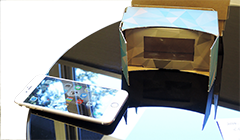
A new RIKEN Venture, SR Laboratories Inc., was recently founded with the goal of putting a simple “substitutional reality” device—called Hacosco—within everyone’s reach.
Substitutional reality, or SR, is a derivative of virtual reality. BSI researcher Naotaka Fuji, who serves as CEO of the venture as well as an affiliated company, Hacosco Inc., which was founded to market its devices, initially developed SR as part of his neuroscience research. “We were looking for a system which could ensure that subjects were provided with a consistent environment during experiments examining social aspects of the brain,” he says. He came up with the idea of replacing reality with a movie filmed using a panoramic camera, allowing the subject to watch the movie from any angle by wearing a special head-mounted device.
"The SR system makes you feel like you are jumping in space and time," says Fujii. "The image follows your head movements as if you are really moving." He believes this is possible because of the existence of a complex mechanism in our brain that allows us to establish a spatial map based on our movement and speed coupled with other environmental information. The discovery of this mechanism, in fact, led to last year’s Nobel Prize for Physiology or Medicine.
The original full-spec SR system, composed of a special room, a head mounted device, and a panoramic video camera with cutting-edge technology, cost more than ten thousand dollars. Due to the cost, Fujii was unable to convince anyone to commercialize his system, despite his conviction that it had a potentially large market. He decided to establish his own company based on the RIKEN Venture system, which helps researchers to launch ventures, and to try to market a cheaper version, called Hacosco.
The new device was made possible thanks to the now ubiquitous smartphone. “We realized,” says Fujii, “that a smartphone has everything needed to drive a very inexpensive and simple SR system. Since Hacosco is made of cardboard, it costs less than ten dollars.”
The fact that it can be shipped in an unfolded form makes it possible to use it as a novelty item. Companies can, for example, distribute it as advertising tools. In November 2014, a Japanese fashion magazine gave readers a limited version of Hacosco with which they could experience a Paris fashion show. An SR system-based attraction, “Nightmare Lab,” opened this month at Huis Ten Bosch, an amusement park in Nagasaki.
The name “Hacosco” comes from the Japanese word hakofor “box” and the English word scope. The box-type device gives us a new scope for sharing our experiences with others beyond place and time.
By Tazu Aoki
